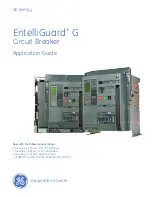
7.6.2
Functionality
SEMOD171959-4 v12
In networks with high impedance earthing, the phase-to-earth fault current is
significantly smaller than the short circuit currents. Another difficulty for earth
fault protection is that the magnitude of the phase-to-earth fault current is almost
independent of the fault location in the network.
Directional residual current can be used to detect and give selective trip of phase-
to-earth faults in high impedance earthed networks. The protection uses the
residual current component 3I
0
· cos φ, where φ is the angle between the residual
current and the residual voltage (-3U
0
), compensated with a characteristic angle.
Alternatively, the function can be set to strict 3I
0
level with a check of angle φ.
Directional residual power can also be used to detect and give selective trip of
phase-to-earth faults in high impedance earthed networks. The protection uses the
residual power component 3I
0
· 3U
0
· cos φ, where φ is the angle between the
residual current and the reference residual voltage, compensated with a
characteristic angle.
A normal non-directional residual current function can also be used with definite or
inverse time delay.
A backup neutral point voltage function is also available for non-directional
residual overvoltage protection.
In an isolated network, that is, the network is only coupled to earth via the
capacitances between the phase conductors and earth, the residual current always
has -90º phase shift compared to the residual voltage (3U
0
). The characteristic
angle is chosen to -90º in such a network.
In resistance earthed networks or in Petersen coil earthed, with a parallel resistor,
the active residual current component (in phase with the residual voltage) should be
used for the earth fault detection. In such networks, the characteristic angle is
chosen to 0º.
As the amplitude of the residual current is independent of the fault location, the
selectivity of the earth fault protection is achieved by time selectivity.
When should the sensitive directional residual overcurrent protection be used and
when should the sensitive directional residual power protection be used? Consider
the following:
•
Sensitive directional residual overcurrent protection gives possibility for better
sensitivity. The setting possibilities of this function are down to 0.25 % of
IBase, 1 A or 5 A. This sensitivity is in most cases sufficient in high
impedance network applications, if the measuring CT ratio is not too high.
•
Sensitive directional residual power protection gives possibility to use inverse
time characteristics. This is applicable in large high impedance earthed
networks, with large capacitive earth fault currents. In such networks, the
active fault current would be small and by using sensitive directional residual
power protection, the operating quantity is elevated. Therefore, better
Section 7
1MRK 506 382-UEN A
Current protection
218
Line distance protection REL650 2.2 IEC
Technical manual
Содержание RELION 650 SERIES
Страница 1: ...RELION 650 SERIES Line distance protection REL650 Version 2 2 Technical manual ...
Страница 2: ......
Страница 46: ...40 ...
Страница 56: ...50 ...
Страница 164: ...158 ...
Страница 264: ...258 ...
Страница 304: ...298 ...
Страница 320: ...314 ...
Страница 338: ...332 ...
Страница 438: ...432 ...
Страница 468: ...462 ...
Страница 534: ...528 ...
Страница 646: ...640 ...
Страница 660: ...654 ...
Страница 676: ...670 ...
Страница 800: ...794 ...
Страница 836: ...830 ...
Страница 890: ...884 ...
Страница 894: ...888 ...
Страница 940: ...934 ...
Страница 941: ...935 ...













































